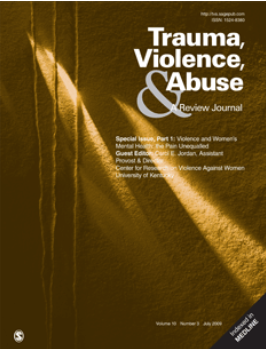急救医务人员的替代性创伤:系统回顾
IF 5.4
1区 社会学
Q1 CRIMINOLOGY & PENOLOGY
引用次数: 0
摘要
紧急医疗服务(EMS)专业人员经常接触到病人所经历的创伤。这种对他人创伤经历的暴露被称为替代创伤或间接创伤。当它对工人的健康造成问题时,由此产生的症状被称为替代性创伤或继发性创伤压力。现有文献强调了认识到这些专业人员所经历的替代性创伤和随后症状的重要性,以及这可能对其工作场所产生的影响。然而,对那些参与院前紧急医疗情况的人的间接创伤的全面审查是有限的。采用四阶段首选报告项目进行系统评价和荟萃分析选择过程,以确定1995年至2022年期间考虑EMS专业人员替代创伤流行病学的出版物。训练有素的审稿人根据纳入标准筛选文章:(a) EMS专业人员;(b)间接创伤/相关名词;(c)对流行病学数据、风险/保护因素或表现进行分析。最初,鉴定了4147份独特的手稿。在删除重复后,一位审稿人筛选标题,并通过参考书目搜索确定其他文章。两位审稿人独立筛选摘要,解决全文筛选过程中的分歧,第三位审稿人解决任何冲突。本综述共纳入31篇文章。本文对替代性创伤的流行病学研究结果进行了总结。替代/间接创伤的职业危害是不可避免的,但替代创伤/继发性创伤压力可以通过改进工作场所措施来减轻。本文章由计算机程序翻译,如有差异,请以英文原文为准。
Vicarious Traumatization Among Emergency Medical Service Personnel: A Systematic Review
Emergency medical services (EMS) professionals are exposed to the trauma experienced by their patients regularly. This exposure to others’ traumatic experiences is known as vicarious trauma or indirect trauma. When it becomes problematic for the worker’s well-being, the resulting symptoms are referred to as vicarious traumatization or secondary traumatic stress. Existing literature highlights the importance of recognizing vicarious trauma and subsequent symptoms experienced by these professionals, as well impacts this may have on their workplaces. However, comprehensive reviews of vicarious traumatization among those involved in responding to prehospital emergency medical situations are limited. A four-phase Preferred Reporting Items for Systematic Reviews and Meta-Analyses selection process was employed to identify publications from 1995 to 2022 that considered the epidemiology of vicarious traumatization among EMS professionals. Trained reviewers screened articles based on inclusion criteria: (a) EMS professionals; (b) vicarious traumatization/related terms; and (c) analysis of epidemiological data on prevalence, risk/protective factors, or manifestations. Initially, 4,147 unique manuscripts were identified. After removing duplicates, one reviewer screened titles, and additional articles were identified through bibliography searches. Two reviewers independently screened abstracts, resolving disagreements during full-text screening, where a third reviewer settled any conflicts. A total of 31 articles were included in this review. Findings regarding the epidemiology of vicarious traumatization are summarized. The occupational hazard of vicarious/indirect trauma is unavoidable, but vicarious traumatization/secondary traumatic stress can be mitigated with improved workplace measures.
求助全文
通过发布文献求助,成功后即可免费获取论文全文。
去求助
来源期刊

Trauma Violence & Abuse
Multiple-
CiteScore
13.60
自引率
7.80%
发文量
131
期刊介绍:
Trauma, Violence, & Abuse is devoted to organizing, synthesizing, and expanding knowledge on all force of trauma, abuse, and violence. This peer-reviewed journal is practitioner oriented and will publish only reviews of research, conceptual or theoretical articles, and law review articles. Trauma, Violence, & Abuse is dedicated to professionals and advanced students in clinical training who work with any form of trauma, abuse, and violence. It is intended to compile knowledge that clearly affects practice, policy, and research.
 求助内容:
求助内容: 应助结果提醒方式:
应助结果提醒方式:


